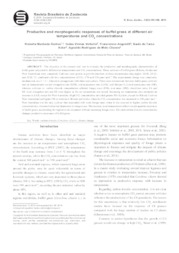Productive and morphogenetic responses of buffel grass at different air temperatures and CO2 concentrations.
Productive and morphogenetic responses of buffel grass at different air temperatures and CO2 concentrations.
Author(s): SANTOS, T. M.; VOLTOLINI, T. V.; ANGELOTTI, F.; AIDAR, S. de T.; CHAVES, A. R. de M.
Summary: The objective of the present trial was to evaluate the productive and morphogenetic characteristics of buffel grass subjected to different air temperatures and CO2 concentrations. Three cultivars of buffel grass (Biloela, Aridus and West Australian) were compared. Cultivars were grown in growth chambers at three temperatures (day/night): 26/20, 29/23, and 32/26 °C, combined with two concentrations of CO2: 370 and 550 ?mol mol?1. The experimental design was completely randomized, in a 3 × 3 × 2 factorial arrangement with three replications. There were interactions between buffel grass cultivars and air temperatures on leaf elongation rate (LER), leaf appearance rate (LAR), leaf lifespan (LL) and senescence rate (SR), whereas cultivars vs. carbon dioxide concentration affected forage mass (FM), root mass (RM), shoot/root ratio, LL and SR. Leaf elongation rate and SR were higher as the air temperature was raised. Increasing air temperature also promoted an increase in LAR, except for West Australian. High CO2 concentration provided greater SR of plants, except for Biloela. Cultivar West Australian had higher FM in relation to Biloela and Aridus when the CO2 concentration was increased to 550 ?mol mol?1. West Australian was the only cultivar that responded with more forage mass when it was exposed to higher carbon dioxide concentrations, whereas Aridus had depression in forage mass. The increase in air temperatures affects morphogenetic responses of buffel grass, accelerating its vegetative development without increasing forage mass. Elevated carbon dioxide concentration changes productive responses of buffel grass.
Publication year: 2014
Types of publication: Journal article
Unit: Embrapa Semi-arid Region
Observation
Some of Embrapa's publications are published as ePub files. To read them, use or download one of the following free software options to your computer or mobile device. Android: Google Play Books; IOS: iBooks; Windows and Linux: Calibre.
Access other publications
Access the Agricultural Research Database (BDPA) to consult Embrapa's full library collection and records.
Visit Embrapa Bookstore to purchase books and other publications sold by Embrapa.

